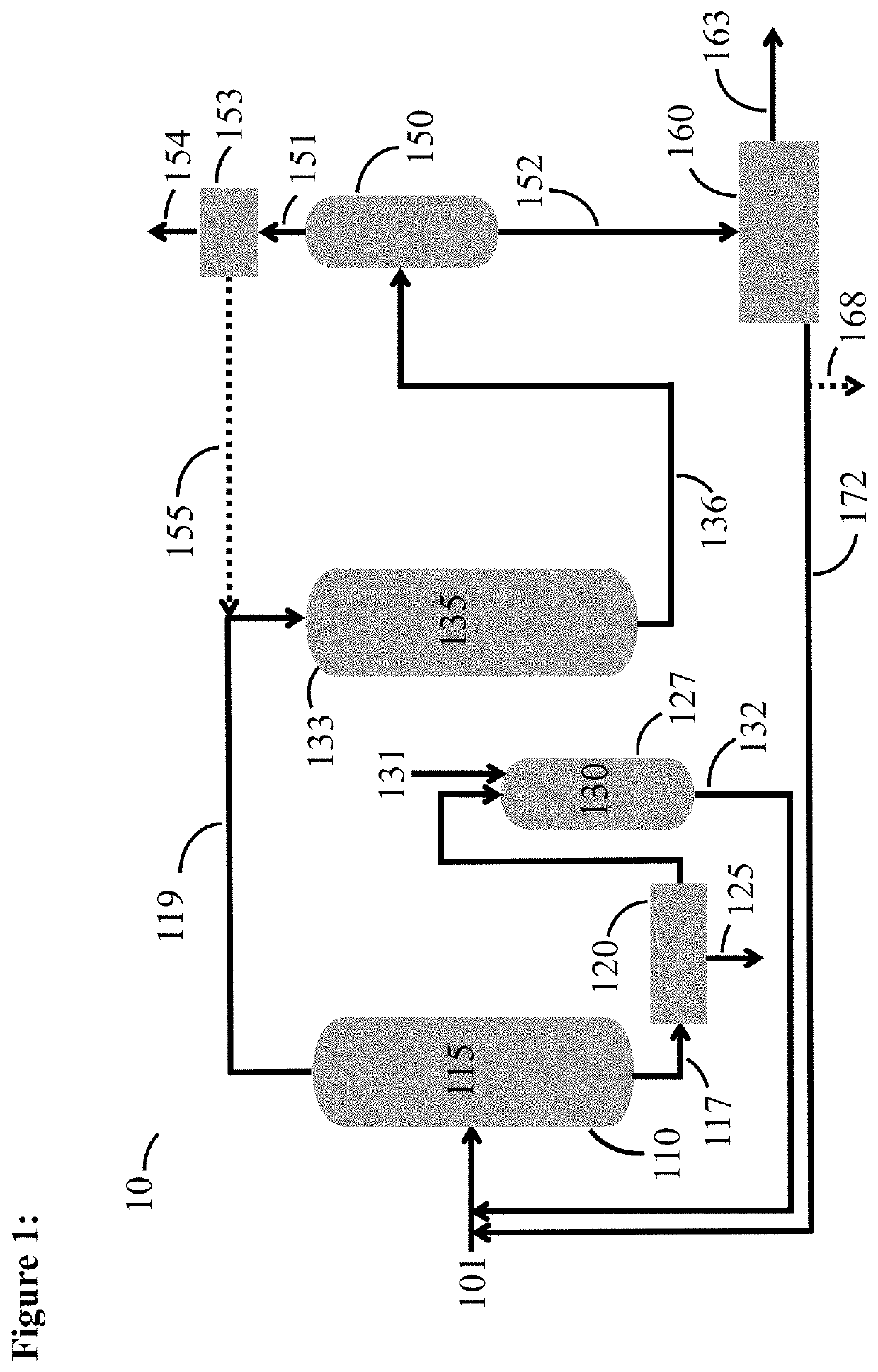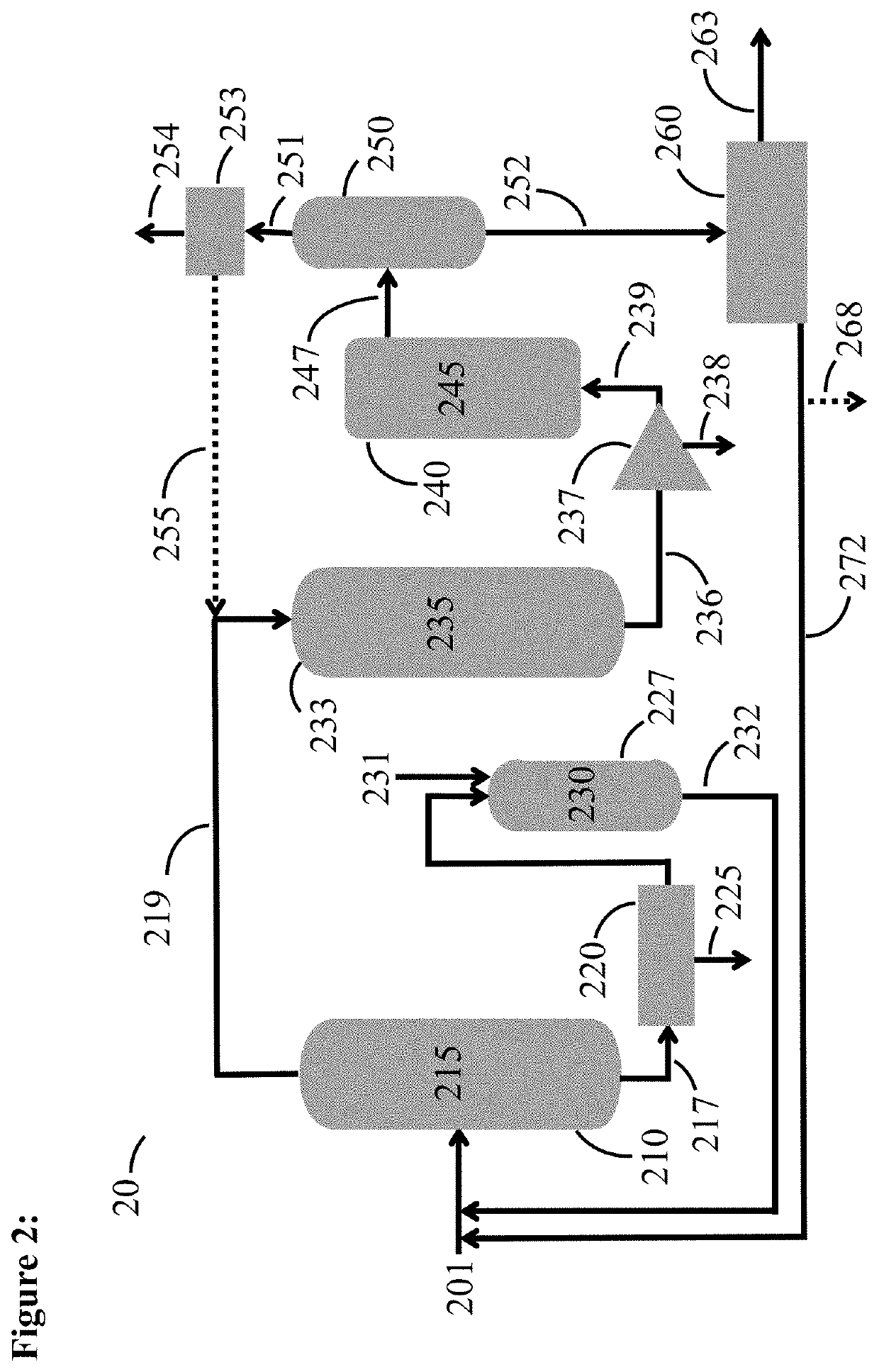Isomerization, catalytic activation and alkylation of pentane-enriched hydrocarbon mixtures
a technology of which is applied in the field of isomerization, catalytic activation and alkylation of pentane-enriched hydrocarbon mixtures, can solve the problems of limited quantity of volatile components that can be blended into finished transportation fuels, and the conventional process of upgrading light alkanes to value-added products is not well-suited to hydrocarbon feed streams, so as to increase the ratio of olefins and reduce the production of aromatics
- Summary
- Abstract
- Description
- Claims
- Application Information
AI Technical Summary
Benefits of technology
Problems solved by technology
Method used
Image
Examples
example 1
[0088]This example demonstrates the preliminary rationale for isomerizing at least a portion of the n-C5 found in a given hydrocarbon feed stream to i-C5 prior to contacting the pentane with an activation catalyst. The graphs below illustrate differences in activation reactivity for n-C5 and i-C5. Feed streams were utilized that comprised either 100 wt. % i-C5 (i-C5), 100 wt. % n-C5 (n-C5), or a 70 wt. % iC5 / 30 wt. % n-C5 mixture (i / n [7:3]) that represents an isomerized pentanes stream that has been contacted with an isomerization catalyst to increase the ratio of i-C5 to n-C5. The catalyst utilized was ⅛″ extrudate consisting of 50 wt. % alumina binder and 50 wt. % ZSM-5 zeolite, and experiments were conducted at a WHSV of 1.3 hr−1 at 1 atm. Results were averaged over the total time on stream of 16 hr.
[0089]FIG. 4 is a bar graph depicting the results of catalytically activating each feed stream at either 550° C. or 600° C. The graph depicts, as percentages, the total catalytic con...
example 2
[0091]This experiment demonstrates that isopentane (i-C5) is advantageously converted by both an activation catalyst and a subsequent oligomerization catalyst to produce a high percentage of product that is suitable for use as a liquid transportation fuel. A 100 wt. % i-C5 feed stream was upgraded by first contacting it with a zeolite activation catalyst, followed by contacting a zeolite oligomerization catalyst. Activation was conducted by contacting the feed stream with ⅛ in. diameter catalyst extrudate consisting of 50 wt. % alumina binder and 50 wt. % ZSM-5 zeolite catalyst at a temperature of 579° C., and a WHSV of 2.6 hr−1 at 1 atm.
[0092]Oligomerization was conducted by contacting the activation effluent with a ZSM-5 zeolite catalyst in a reactor where the inlet temperature for the activation effluent was maintained at 250° C., the pressure was 1 atm, and the WHSV for the feed stream was 1.3 hr−1. Results were time-averaged over 16 hours. The table shows the product distributi...
example 3
[0095]This experiment demonstrates that isopentane (i-C5) is advantageously converted by both an activation catalyst and a subsequent alkylation catalyst to produce a high percentage of product that is suitable for use as a liquid transportation fuel. A 100 wt. % i-C5 feed stream was upgraded by first contacting it with a zeolite activation catalyst, followed by contacting the activation effluent with a zeolite alkylation catalyst. Activation was conducted by contacting the feed stream with a ⅛ in. diameter catalyst extrudate consisting of 50 wt. % alumina binder and 50 wt. % ZSM-5 zeolite catalyst in an activation reactor. The temperature of the activation reactor at the inlet for the feed stream was 579° C., the pressure was 1 atm, and the WHSV for the feed stream was 2.6 hr−1. Alkylation was then conducted by contacting the effluent with a ZSM-5 catalyst in a reactor where the temperature at the inlet for the feed stream was 230° C., the pressure was maintained at 15 psig and the...
PUM
| Property | Measurement | Unit |
|---|---|---|
| wt. % | aaaaa | aaaaa |
| pressure | aaaaa | aaaaa |
| temperature | aaaaa | aaaaa |
Abstract
Description
Claims
Application Information
 Login to View More
Login to View More - R&D
- Intellectual Property
- Life Sciences
- Materials
- Tech Scout
- Unparalleled Data Quality
- Higher Quality Content
- 60% Fewer Hallucinations
Browse by: Latest US Patents, China's latest patents, Technical Efficacy Thesaurus, Application Domain, Technology Topic, Popular Technical Reports.
© 2025 PatSnap. All rights reserved.Legal|Privacy policy|Modern Slavery Act Transparency Statement|Sitemap|About US| Contact US: help@patsnap.com



